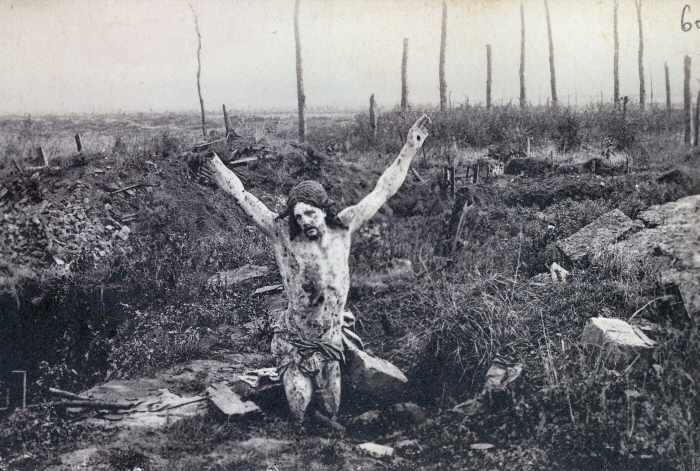The Crucifix at Givenchy. A Story of the Great War

It was the Portugese soldiers (during the Battle of the Lys in 1918) who took the “Christ of the Trenches” into their positions with them. The figure is now in Portugal commemorating Portugal’s Unknown Soldier. http://www.ww1battlefields.co.uk/others/neuve_chapelle_short.html
It is Holy Week and I will shortly be taking off for a little rest and family time. Here is a story from the Great War.
I fear the solitude of the night, but I can never ascertain what it is I fear in it. I am not particularly interested in the supernatural, and spiritualism and table-rapping is not at all to my taste. In a crowded room a spirit in my way of thinking loses its dignity and power to impress, and at times I am compelled to laugh at those who believe in manifestations of disembodied spirits.
Once, at Givenchy, a soldier in all seriousness spoke of a strange sight which he had seen. Givenchy Church has only one wall standing, and a large black crucifix with its nailed Christ is fixed to this wall. From the trenches on a moonlight night it is possible to see the symbol of sorrow with its white figure which seems to keep eternal watch over the line of battle. The soldier of whom I speak was on guard; the night was very clear, and the enemy were shelling Givenchy Church. A splinter of shell knocked part of the arm of the cross away. The soldier on watch vowed that he saw a luminous halo settle round the figure on the Cross. It detached itself from its nails, came down to the ground, and put the fallen wood back to its place. Then the Crucified resumed His exposed position again on the Cross. It was natural that the listeners should say that the sentry was drunk.
It is strange how the altar of Givenchy Church and its symbol of Supreme Agony has escaped destruction. Many crosses in wayside shrines have been untouched though the locality in which they stand is swept with eternal artillery fire.
But many have fallen; when they become one with the rubble of a roadway their loss is unnoticed. It is when they escape destruction that they become conspicuous. They are like the faithful in a storm at sea who prayed to the Maria del Stella and weathered the gale. Their good fortune became common gossip. But gossip, historical and otherwise, is mute upon those who perished.
The Great Push: An Episode of the Great War, Patrick MacGill, 1916
There are many stories from the lives of the saints about Christ loosening a hand and reaching down to embrace the favored one. In this case, the Carpenter merely repairs His cross and climbs back onto it. The darkness of the scene reminds me of the 1940 poem “Still Falls the Rain,” by Edith Sitwell.
And see this previous post on an uncanny crucifix in Burgos Cathedral.
Chris Woodyard is the author of The Victorian Book of the Dead, The Ghost Wore Black, The Headless Horror, The Face in the Window, and the 7-volume Haunted Ohio series. She is also the chronicler of the adventures of that amiable murderess Mrs Daffodil in A Spot of Bother: Four Macabre Tales. The books are available in paperback and for Kindle. Indexes and fact sheets for all of these books may be found by searching hauntedohiobooks.com. Join her on FB at Haunted Ohio by Chris Woodyard or The Victorian Book of the Dead. And visit her newest blog, The Victorian Book of the Dead.
